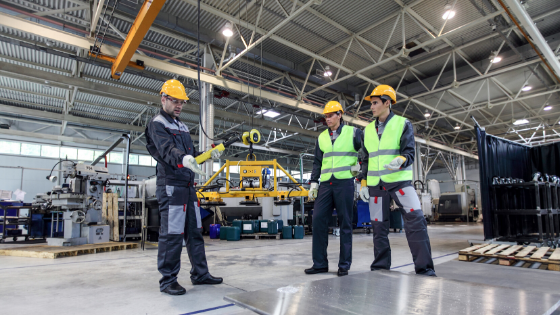GENERAL
Building a Strong Safety Culture: A Comprehensive Guide

Building a strong safety culture requires commitment from all levels of an organization, starting with leadership. It involves clear communication about safety policies, continuous training, and fostering an environment where employees feel empowered to report hazards. Setting measurable safety goals and recognizing safe behaviors can encourage active participation. Regular safety audits and reviews help identify risks, and addressing them promptly demonstrates accountability. A collaborative approach ensures that safety becomes ingrained in everyday operations, reducing accidents and promoting a healthy, secure work environment for all employees.
Introduction
Creating a strong safety culture is paramount for any organization aiming to protect its employees and ensure a productive work environment. A proactive safety culture in the workplace minimizes accidents and injuries and enhances morale, productivity, and job satisfaction. This culture reflects shared values and practices emphasizing prevention rather than reaction, integrating safety into all areas of the organization’s operations and making it a core priority. This article will cover in-depth tactics and advice on creating a strong workplace safety culture.
The Importance of Safety Culture
Safety culture refers to the shared beliefs, practices, and mindsets that determine how an organization approaches safety. An influential safety culture prioritizes safety management systems, continuous learning, and proactive measures to prevent accidents before they occur. This proactive attitude is crucial as it signifies a shift from merely complying with safety regulations to embedding safety as a core value within the organization. Research has shown that companies with strong safety cultures experience fewer workplace accidents, lower staff turnover, and higher levels of job satisfaction. Furthermore, a robust safety culture can enhance an organization’s reputation and reduce legal and financial liabilities.
Actionable Strategies to Foster a Safety Culture
Leadership Commitment
Establishing a safety culture requires strong leadership. When management visibly prioritizes safety, employees are more likely to follow suit. This means allocating resources, setting clear safety expectations, and leading by example. By starting safety campaigns, attending safety training sessions, and often bringing up safety issues at meetings, leaders may show their dedication to the cause. To further emphasize their commitment, leaders should celebrate safety milestones and recognize employees contributing to a safer workplace. This visible and active involvement from leadership sets a precedent and builds trust among employees, showing that safety is a priority from the top down.
Comprehensive Training Programs
Training regimens that are comprehensive and consistent are crucial. Workers need to know the ins and outs of safety practices. Incorporating hands-on training, interactive modules, and periodic refreshers ensures that information remains fresh and top of mind. Effective training programs are tailored to different organizational roles’ specific needs and risks. For instance, new employees might require a comprehensive onboarding program, while experienced staff benefit from advanced or specialized training sessions. Supplemental resources such as safety bulletins, instructional videos, and safety drills can reinforce the training. Employers may maintain a high level of worker readiness and safety awareness by making training a continuous process instead of a one-time occurrence.
Open Communication Channels
Encourage open communication about safety concerns and suggestions. Establishing anonymous reporting systems can help employees feel safer voicing potential hazards. CDC’s guide on safety culture emphasizes the importance of fostering an environment where everyone feels responsible for safety. Regular safety meetings and suggestion boxes are practical tools for gathering feedback and encouraging dialogue. Moreover, promptly addressing reported concerns and providing input on implemented changes reinforces the idea that employees’ voices matter. This culture of openness helps identify and mitigate risks and enhances cooperation and trust throughout the organization.
Real-Life Examples of Successful Safety Initiatives
Many companies have successfully implemented safety culture initiatives. For example, a manufacturing firm reduced workplace accidents by introducing a peer-review safety program. This program empowered employees to conduct safety audits, identify potential hazards, and recommend improvements, fostering a sense of ownership and accountability. Similarly, a healthcare organization saw improved employee health by launching a wellness program focused on ergonomics and mental health support. With the help of this comprehensive approach, which addressed physical and psychological health, the workforce became more resilient and engaged. Another notable example is a construction company that introduced a safety incentive program, rewarding teams for maintaining accident-free records, which instilled a competitive spirit and heightened safety awareness.
Continuous Improvement Through Data and Feedback
Gathering data and feedback is crucial for continuous improvement. Regularly review accident reports, conduct safety audits, and utilize employee surveys to gather insights. Use this data to refine existing safety practices and develop new ones, ensuring your safety culture evolves with changing needs. Implementing a robust incident tracking system can help identify trends and root causes while comparing data across departments and highlighting areas needing attention. Engaging with external safety consultants can provide fresh perspectives and innovative solutions. Organizations may maintain a dynamic and successful safety program and remain ahead of new hazards by cultivating a learning and continuous improvement culture.
Conclusion
Incorporating these strategies can significantly enhance your workplace safety culture. From leadership commitment to continual development, every element is required to build a safe and effective work environment. By prioritizing safety, you empower employees and build a foundation for long-term success. Remember, a strong safety culture is an ongoing journey that requires dedication and adaptability. With persistent effort and a proactive attitude, you can create an atmosphere where safety is engrained in every activity and decision, eventually resulting in a happier, healthier, and more productive workforce.
GENERAL
How Dmytro Makarov Stays Productive at the Helm of a Global Agency

Dmytro Makarov’s Discipline-Fueled Strategy for Leading Through Growth
Dmytro Makarov has become a leading voice in global marketing by staying relentlessly focused on what most overlook – discipline, routine and deep thinking. Born in Kyiv in 2001, Makarov never followed a traditional academic or corporate path. After leaving school in eighth grade, he committed to self-education, real-world learning and an unshakable work ethic that would fuel the rise of a 100-person marketing agency before he turned 24.
Now, after running campaigns for brands such as BMW, Hugo, Domino’s Pizza and Kyivstar, Makarov says his greatest accomplishment is not global reach – it is sustaining clarity, energy and purpose at the pace of constant expansion.
A Morning Code of Focus
At the center of Dmytro Makarov’s productivity is one core principle: structure equals freedom. “The most important part of my day is the morning,” he says. “That is when I build my focus and set the tone.”
That is why he starts each morning with a fixed, quiet ritual. By 7:30 a.m., he is up with black coffee in hand and no devices. For 20 minutes, he plans, reflects and sets priorities. “This time gives me space to think clearly,” Makarov explains. “Every day, I aim to absorb one new concept – from a book, a podcast or a trusted news source.”
The rest of his day is broken into clear focus blocks:
- 8:00 a.m. – 9:30 a.m.: Strategy, review, key decisions.
- 10:00 a.m. – 7:00 p.m.: Client management, team check-ins, campaign execution.
- Evening: Fitness, reading, reflection – often paired with war news or historical documentaries.
Makarov also integrates movement into his routine, whether a gym session or a long outdoor walk. “Mental stamina depends on physical health,” he says. “This rhythm is my anchor – it is what keeps me sharp.”
Essence Over Spotlight
Despite delivering blockbuster results – including 524 campaigns and billions of digital impressions Dmytro Makarov keeps his team grounded in effectiveness, not flash.
“Views and likes can be meaningless without purpose,” he says. “We do not chase noise. We chase results that make an impact.”
His campaigns often win attention because of cultural relevance. One Intel launch used trusted tech influencers to spark genuine conversations. A Durex campaign reached over 3 million people through smart integration into gaming communities, not gimmicks.
“The right message always beats the loudest one,” Makarov notes. “It is about trust – something ads alone can not buy.”
Building With Intention
When growing his agency, Makarov focused on more than just hiring talent – he built a mission-driven culture. His global team now operates across the U.S., Europe, Asia and the Middle East.
Dmytro Makarov believes in rebuilding when needed. “I have started from scratch more than once. I am not afraid of that,” he says. “What matters is knowing why you do it – and who you are doing it with.”
Leading With Meaning
Even after earning major clients and international accolades, Dmytro Makarov says his true success lies elsewhere.
“What am I proudest of? Staying true to my values, especially in chaos – whether it is growth, setbacks or even war,” he says. “And building a team I believe in, and that believes in what we do.”
He finds personal motivation in unexpected places: Ukraine’s defenders, local volunteers, and quiet time spent disconnected from screens.
Makarov remains committed to purpose over hype. He insists he is not smarter than people around him. “But I work hard, keep learning and focus on what matters. That is how you build something that lasts.”
GENERAL
How TeraBox Powers Your Workflow

Have you ever wondered how companies manage to keep everything in order? All of this is possible because of online business tools!
Businesses use tools like TeraBox to manage time, organize activities, and ensure that everyone is collaborating efficiently.
For any firm to function more effectively, business management solutions are essential. In the quick-paced market of today, these instruments help in the expansion of your company.
They help you do more and make things easier. Having the appropriate tools for an online business is essential for success, regardless of the size of your company.
But here, a question may pop up in your mind: “What can these tools do for you, and why are they so crucial?” Or, “How can they transform your business operations for the better?”
Well, let’s find out!
What Makes the Best Online Business Tools
If the internet has given us anything, it’s abundance. So, what are online planning tools in business? What is the best way to choose among the many tools offered in each category?
When selecting online business tools, you should take into account the following features:
- Offline capabilities
- Integrations
- Scalability
- Cost
- Ease-of-use
- Customer support
- Customer reviews
At this point, is there a business tool that offers you such qualities? Well, the answer is yes, as TeraBox is the only tool you may need. With its AI features, TeraBox will perfectly suit all your business needs.
Here is how it will help you with your tasks:
1) Presentation Creation
TeraBox makes it simple to store, retrieve, and distribute presentation files from any location, ensuring that you’re always prepared to create, modify, or deliver—whether at home, at work, or while on the move!
2) Document Scanning
TeraBox makes document scanning simple—just snap a photo, upload, and store important presentation notes or papers safely in the cloud for easy access anytime.
3) Article Paraphrasing
TeraBox helps with article paraphrasing by letting you store drafts, access reference materials anytime, and sync your work across devices, making writing and editing smooth and stress-free.
4) Audio-to-Text Transcribe
TeraBox lets you store and access audio files easily, so you can upload recordings and use transcription tools to convert them to text anytime, from any device.
Best Online Business Tools for Communication and Marketing

Having the appropriate tools for an online business can significantly impact the quality of your conversations, whether you’re speaking with your network, freelancers, team, or clients.
Use these excellent scheduling and communication tools to collaborate and communicate with ease. There are several tools available that could assist you in engaging your audience.
Let’s explore a few of these tools and their excellent features.
1. Canva
Canva, one of the most widely used graphic design tools available, provides all the features you need to produce clean, expert visuals for your company. It is an excellent tool for producing material on social media, including LinkedIn Carousels and Instagram Stories.
Not only this, it’s also simple to publish and post your designs right away because of their interfaces with popular social media scheduling tools like Hootsuite, Later, and Buffer.
Key Features:
- Pre-built professional-quality templates
- Integrations with social media scheduling tools
- User-friendly drag-and-drop builder
2. Microsoft Teams
If you’re looking for the best tool for teamwork at work, then Microsoft Teams is the one you should go for. It offers a fully functional environment for online meetings, chat, and document storage. One essential part of Microsoft 365 is Teams.
You’ll understand the necessity for such a user-friendly application if you’ve ever had to take part in a collaborative project at work.
Each program has a somewhat different set of features and benefits and is made for teamwork. When it comes to group projects, Microsoft Teams is your new best buddy.
Key Features:
- Instant chats
- Reduced email
- Fast searching for information
3. Mailchimp
For many years, Mailchimp has topped the list of email marketing software reviews. And there’s a good reason why! Simply put, Mailchimp excels at email marketing.
It streamlines the process of developing and automating email marketing campaigns and is feature-rich and scalable.
Additionally, research conducted by emailtooltester found that Mailchimp’s average email deliverability over the last three test rounds is 91.18%, which is rather remarkable!
Key Features:
- User-friendly interface
- Robust automation features
- Comprehensive analytics
Best Online Business Tools for Analytics and Data

Professionals always try to use the right online business tools for data analysis whenever making their deals, as this will help them extract important data, which helps them in making decisions.
But it doesn’t end here! Data analysis also helps them in leading their projects, making vivid judgments, and interacting with their audiences.
So, in short, if we say that data analysis is a one-stop solution to achieving your goals, it wouldn’t be wrong. Let’s have a look at some of the best data analytics tools on the market today.
1. Tableau
Tableau arranges different kinds of data into visual representations to facilitate analysis and explanation. These days, not only companies but also individuals are using it to gain a better understanding of data that can help them with real-time struggles and make decisions more quickly.
Key Features:
- Charts: Treemaps, histograms, scatterplots, packed bubble charts, box and whisker plots, pie charts, bar charts, line charts, and histograms are all examples of Tableau graphics.
- Data blending: This feature allows you to compare different data sets to find the right answers to questions or help you better understand the case properly.
- Sharing and collaboration: You can use products like Tableau Server and Tableau Cloud to collaborate on projects with co-workers or other parties pulling from the same data.
2. Google Analytics
Google Analytics is a web analytics service that offers a wide range of analytical tools for understanding marketing campaigns and website performance. This online analytics solution offers statistics and fundamental analytical tools for marketing and search engine optimisation.
Key Features:
- Track online traffic: Google Analytics monitors website traffic, including the number of visitors, page views, bounce rate, and session duration.
- Conversion tracking: Google Analytics allows you to track specific actions (conversions) that are important to your business, like purchases or form submissions.
- SEO optimization: It provides data to improve your website’s search engine ranking by identifying popular keywords and content gaps.
Best Online Business Tools for Content Creation and Storage
No matter what area of marketing you are an expert in, a good all-in-one tool is always necessary and worth the money. So let us explore two tools that can streamline your content creation.
1. TeraBox
TeraBox is a cutting-edge cloud storage solution that provides an extensive feature set to improve your experience with file sharing, video storage, and document backup.
Its ample 1 TB (1024 GB) of secure cloud storage allows for smooth file transfers between all of your devices while guaranteeing that your data is secure and readily available.
Additionally, TeraBox has launched Tera AI, making it a feature-rich platform that provides a variety of AI content production tools. It provides all the tools you need on one platform to save time and boost creativity.
Key Features:
- AI presentation maker
- Secure document backup
- Versatile file upload
- Enhanced privacy measures
- Effortless sharing via iMessage
2. Adobe Creative Cloud (CC)
Adobe Creative Cloud has transformed the way creative projects are planned, carried out, and delivered, making it the preferred choice for both professionals and enthusiasts.
Its importance in the creative industries cannot be emphasized enough because it provides a wide range of tools and resources that enable people and organizations to realize their full creative potential.
Key Features:
- Suite of creative software
- Access to Adobe Stock for assets and resources
- Cloud-based storage and file syncing
- Flexibility and accessibility across devices
- Enhanced workflow efficiency and productivity
How to Build Your Perfect Tool Stack

It is essential to build the appropriate tech stack for your product when you are dealing with data. A well-built technology stack forms the basis of your web application, allowing it to accommodate the changing needs of your users and provide a smooth user experience.
Here’s how you build the best technological stack:
Step 1: Define your product’s requirements
Step 2: Choose a suitable programming language
Step 3: Pick the appropriate frameworks and libraries
Step 4: Select the right database technology
Step 5: Consider infrastructure and hosting options
Step 6: Prioritise security and scalability
Step 7: Test and optimise
Conclusion
If you are working on different content and having an exceptional performance becomes your absolute need, then you have to choose the right business tool. And when it comes to the best business tool that will help you in making a great business presentation, then you need to choose TeraBox.
As it is a stop solution for all your problems with its robust AI capabilities, safe cloud storage, and intuitive design, the quality of your content will go beyond excellence. So why wait? Try TeraBox now and see how easy it is to stay productive and competitive!
GENERAL
Best Places to Buy Monopoly GO Stickers Online – U4GM Review

Monopoly GO has taken the cellular gaming global via typhoon, mixing classic Monopoly gameplay with fun, fast-paced sticky label collections. As players race to complete their albums, getting the proper stickers turns into crucial—but what if you’re stuck lacking a few key portions? That’s where searching for Monopoly GO stickers comes in.
If you are looking for a secure, rapid, and dependable way to shop for Monopoly GO stickers, you’ve come to the right vicinity. In this guide, we’ll explore the outstanding systems to buy stickers, why U4GM sticks out, and the manner to keep away from scams at the same time as getting the quality deals.
Why Buy Monopoly GO Stickers?
Before diving into wherein to shop for them, allows recognize why gamers pick to shop for stickers:
✅ Complete Albums Faster – Some stickers are quite rare, and shopping for and selling isn’t constantly smooth. Buying them quickens development.
✅ Save Time & Effort – Instead of awaiting random drops or hoping for trades, you could get exactly what you need.
✅ Get Ahead in Events – Many activities require precise stickers, and looking for them can help you win rewards faster.
✅ Avoid Scams – Reputable dealers ensure strong transactions, in contrast to unstable peer-to-peer trades.
Now, permit’s have a look at the awesome locations to buy Monopoly GO stickers online.
1. U4GM – The Best Marketplace for Monopoly GO Stickers
When it comes to buying in-sport items, U4GM is one of the most relied on structures. Here’s why:
✔ Why Choose U4GM?
- Verified Sellers – No scams or faux listings; each vendor is checked.
- Instant Delivery – Get your stickers immediately after purchase.
- Competitive Prices – Often much less high priced than different marketplaces.
- 24/7 Customer Support – Quick assist in case you come upon any problems.
- Secure Payments – Multiple fee options, in conjunction with PayPal and credit gambling playing cards.
✔ How to Buy from U4GM
- Visit U4GM’s Monopoly GO Stickers web web page.
- Browse to get stickers and pick the ones you need.
- Choose a dealer with suitable ratings.
- Complete the purchase and accumulate your stickers immediately!
👉 Buy Monopoly GO Stickers Here 👈
2. PlayerAuctions – A Reliable Peer-to-Peer Marketplace
PlayerAuctions is another famous platform for getting in-sport objects, which includes Monopoly GO stickers.
✔ Pros:
- Large choice of dealers.
- Escrow protection for safer transactions.
- User opinions help end up aware of honest dealers.
✘ Cons:
- Prices can vary extensively.
- Some sellers can also take longer to supply.
3. EBay – Buyer Protection however Higher Prices
eBay is a popular market in which you may find Monopoly GO stickers, but it has a few drawbacks.
✔ Pros:
- eBay’s money-again guarantee protects buyers.
- Some sellers offer bulk gives.
✘ Cons:
- Prices are regularly inflated.
- Risk of fake listings or not on time deliveries.
4. Discord & Reddit – Risky however Possible
Some game enthusiasts promote stickers on Discord servers or Reddit groups.
✔ Pros:
- Potential for direct offers with players.
- Sometimes less expensive than marketplaces.
✘ Cons:
- High rip-off threat – No consumer protection.
- Requires cautious vetting of sellers.
How to Avoid Scams When Buying Monopoly GO Stickers
Since Monopoly GO doesn’t formally resource sticky label buying and promoting for actual cash, scams are common. Here’s the way to live safe:
🔹 Use Trusted Platforms (Like U4GM) – Avoid random social media sellers.
🔹 Check Seller Reviews – Look for excessive scores and excessive first-rate remarks.
🔹 Avoid Too-Good-to-Be-True Deals – Extremely low costs are regularly scams.
🔹 Prefer Secure Payment Methods – PayPal or credit score playing cards provide purchaser protection.
Final Verdict: Where Should You Buy Monopoly GO Stickers?
After reviewing the best alternatives, U4GM is the top desire for:
✔ Safety & reliability
✔ Fast shipping
✔ Competitive pricing
If you want a hassle-free manner to shop for Monopoly GO stickers, U4GM’s marketplace is the great bet.
FAQs About Buying Monopoly GO Stickers
Q: Is purchasing for Monopoly GO stickers allowed?
A: While Scopely doesn’t formally suggest it, many gamers buy stickers as it should be thru relied on dealers.
Q: How speedy will I get my stickers after searching for?
A: On U4GM, shipping is generally on the spot or within minutes.
Q: Can I get scammed at the same time as looking for stickers?
A: Yes, if you use unverified dealers. Stick to trusted systems like U4GM to keep away from scams.
Conclusion
If you’re uninterested in watching for the proper stickers or suffering with unfair trades, shopping for them from a depended on delivery like U4GM is the excellent answer. With solid transactions, rapid shipping, and competitive expenses, you could whole your albums and dominate Monopoly GO without the pressure.
-

 GENERAL2 years ago
GENERAL2 years agoDiscovering the Artistic Brilliance of Derpixon: A Deep Dive into their Animation and Illustration
-

 Posts2 years ago
Posts2 years agoSiegel, Cooper & Co.
-

 FASHION2 years ago
FASHION2 years agoThe Many Faces of “λιβαισ”: A Comprehensive Guide to its Symbolism in Different Cultures
-

 Lifestyle2 years ago
Lifestyle2 years agoPurenudism.com: Unveiling the Beauty of Naturist Lifestyle
-

 Lifestyle2 years ago
Lifestyle2 years agoBaddieHub: Unleashing Confidence and Style in the Ultimate Gathering Spot for the Baddie Lifestyle
-

 HEALTH2 years ago
HEALTH2 years agoTransformative Health Solutions: Unveiling the Breakthroughs of 10x Health
-

 Entertainment2 years ago
Entertainment2 years agoGeekzilla Podcast: Navigating the World of Pop Culture, Gaming, and Tech
-

 Lifestyle11 months ago
Lifestyle11 months agoSandra orlow: Unraveling the Story of an Iconic Figure
